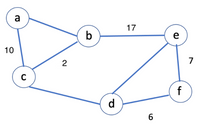
Computer Networking: A Top-Down Approach (7th Edition)
7th Edition
ISBN: 9780133594140
Author: James Kurose, Keith Ross
Publisher: PEARSON
expand_more
expand_more
format_list_bulleted
Question
The edge weights of only those edges that are in the MST are given in graph G (screenshot). What is the minimum possible summation of edge weights for the edges (a, b), (e, d), (c, d)?. As you justify your answer for edge weights, please use graph G and apply Kruskal’s

Transcribed Image Text:10
a
C
2
b
d
17
6
e
f
7

Transcribed Image Text:10
a
C
2
b
d
17
6
e
f
7
Expert Solution
This question has been solved!
Explore an expertly crafted, step-by-step solution for a thorough understanding of key concepts.
Step by stepSolved in 3 steps with 3 images

Knowledge Booster
Similar questions
- Mark Zuckerberg, the CEO of Facebook, has hired you to lead the Facebook Algorithms Group. He has asked you to use various graph algorithms to analyze the world's largest social network. The Facebook Graph has 2.8 billion vertices, with each vertex being a Facebook user. Two vertices are connected provided those two users are "friends". The first decision you need to make is how you want to model the Facebook graph. Determine whether you should use an adjacency-list representation or an adjacency-matrix representation.arrow_forwardConsider the following edge-weighted digraph with 8 vertices and 13 edges. V->W weight A->E 1 A->B B->C C->F 4 C->D D->G F->E 39 23 F->B 26 F->A 16 G->F G->C 40 34 H->D 95 H->G 17 Here is a graphical representation of the same edge-weighted digraph: (A) -3---->(B) -39-->(D) 16 95 (E)- -23- (F). 40 (G) (H) Suppose that you run the Bellman-Ford algorithm to compute the shortest paths from H to every other vertex. What is the distTo[] array immediately after the end of three passes of the algorithm (pass 1, 2, and 3)? Each pass consists of relaxing the 13 edges in the order given above. Here is the distTo[] array before the beginning of pass 1: v A B CDE F H. distTo(v] Answer Your answer should be a sequence of 8 integers, separated by whitespace,arrow_forwardCould you also do question one pleasearrow_forward
- Consider the following descriptions for one sample of six zones: Z1 matches B or D; Z2 matches C, E, or F; Z3 matches A or F; Z4 matches B or D; Z5 matches C or F; and Z6 matches D. (a) (A-F). Draw the bipartite graph that models the zones (Z1-Z6) and the letters they match (b) district layout. Use Hall's theorem to determine if algorithm will be able to successfully create aarrow_forwardCreate a Python implementation of the provided image using the criteria below:Iteratively removes the edge with the highest weight from T until the specified number of 4 clusters is obtained after first creating the MST T of the provided weighted graph in Figure. It should be noted that this algorithm can be easily modified to evaluate edge weights of T that are greater than.arrow_forwardConsider this graph with 11 vertices and 20 edges. Our goal is to colour each of the 11 vertices with one of three colours (Apricot, Brown, Cyan) so that no edge joins two vertices of the same colour. For example, if the vertex 6 is coloured Brown, then the four vertices adjacent to this vertex (10, 5, 2, 7) cannot be coloured Brown, since that would create a Brown-Brown edge. If we can assign a colour to each vertex so that no edge joins two vertices of the same colour, then we say that this graph is 3-Colourable. If this task is impossible (i.e., no matter what, we must create at least one edge joining two vertices of the same colour), then we say that this graph is not 3-Colourable. Determine whether this graph is 3-Colourable. Answer either YES or NO.arrow_forward
arrow_back_ios
arrow_forward_ios
Recommended textbooks for you
 Computer Networking: A Top-Down Approach (7th Edi...Computer EngineeringISBN:9780133594140Author:James Kurose, Keith RossPublisher:PEARSON
Computer Networking: A Top-Down Approach (7th Edi...Computer EngineeringISBN:9780133594140Author:James Kurose, Keith RossPublisher:PEARSON Computer Organization and Design MIPS Edition, Fi...Computer EngineeringISBN:9780124077263Author:David A. Patterson, John L. HennessyPublisher:Elsevier Science
Computer Organization and Design MIPS Edition, Fi...Computer EngineeringISBN:9780124077263Author:David A. Patterson, John L. HennessyPublisher:Elsevier Science Network+ Guide to Networks (MindTap Course List)Computer EngineeringISBN:9781337569330Author:Jill West, Tamara Dean, Jean AndrewsPublisher:Cengage Learning
Network+ Guide to Networks (MindTap Course List)Computer EngineeringISBN:9781337569330Author:Jill West, Tamara Dean, Jean AndrewsPublisher:Cengage Learning Concepts of Database ManagementComputer EngineeringISBN:9781337093422Author:Joy L. Starks, Philip J. Pratt, Mary Z. LastPublisher:Cengage Learning
Concepts of Database ManagementComputer EngineeringISBN:9781337093422Author:Joy L. Starks, Philip J. Pratt, Mary Z. LastPublisher:Cengage Learning Prelude to ProgrammingComputer EngineeringISBN:9780133750423Author:VENIT, StewartPublisher:Pearson Education
Prelude to ProgrammingComputer EngineeringISBN:9780133750423Author:VENIT, StewartPublisher:Pearson Education Sc Business Data Communications and Networking, T...Computer EngineeringISBN:9781119368830Author:FITZGERALDPublisher:WILEY
Sc Business Data Communications and Networking, T...Computer EngineeringISBN:9781119368830Author:FITZGERALDPublisher:WILEY

Computer Networking: A Top-Down Approach (7th Edi...
Computer Engineering
ISBN:9780133594140
Author:James Kurose, Keith Ross
Publisher:PEARSON

Computer Organization and Design MIPS Edition, Fi...
Computer Engineering
ISBN:9780124077263
Author:David A. Patterson, John L. Hennessy
Publisher:Elsevier Science

Network+ Guide to Networks (MindTap Course List)
Computer Engineering
ISBN:9781337569330
Author:Jill West, Tamara Dean, Jean Andrews
Publisher:Cengage Learning

Concepts of Database Management
Computer Engineering
ISBN:9781337093422
Author:Joy L. Starks, Philip J. Pratt, Mary Z. Last
Publisher:Cengage Learning

Prelude to Programming
Computer Engineering
ISBN:9780133750423
Author:VENIT, Stewart
Publisher:Pearson Education

Sc Business Data Communications and Networking, T...
Computer Engineering
ISBN:9781119368830
Author:FITZGERALD
Publisher:WILEY